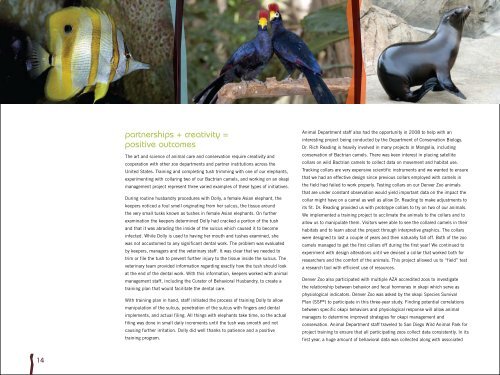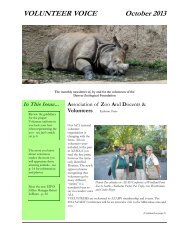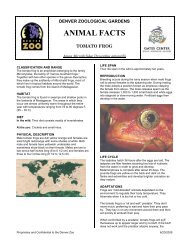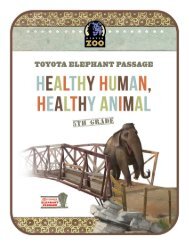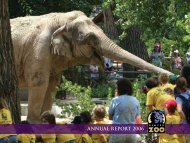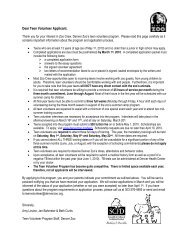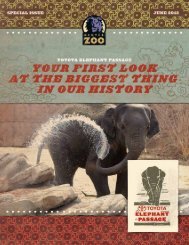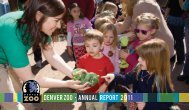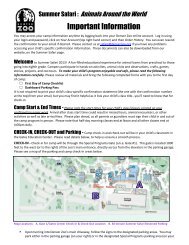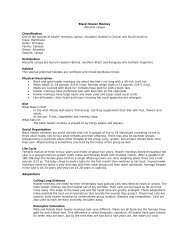2008 Annual Report - Denver Zoo
2008 Annual Report - Denver Zoo
2008 Annual Report - Denver Zoo
- No tags were found...
Create successful ePaper yourself
Turn your PDF publications into a flip-book with our unique Google optimized e-Paper software.
partnerships + creativity =positive outcomesThe art and science of animal care and conservation require creativity andcooperation with other zoo departments and partner institutions across theUnited States. Training and completing tush trimming with one of our elephants,experimenting with collaring two of our Bactrian camels, and working on an okapimanagement project represent three varied examples of these types of initiatives.During routine husbandry procedures with Dolly, a female Asian elephant, thekeepers noticed a foul smell originating from her sulcus, the tissue aroundthe very small tusks known as tushes in female Asian elephants. On furtherexamination the keepers determined Dolly had cracked a portion of the tushand that it was abrading the inside of the sulcus which caused it to becomeinfected. While Dolly is used to having her mouth and tushes examined, shewas not accustomed to any significant dental work. The problem was evaluatedby keepers, managers and the veterinary staff. It was clear that we needed totrim or file the tush to prevent further injury to the tissue inside the sulcus. Theveterinary team provided information regarding exactly how the tush should lookat the end of the dental work. With this information, keepers worked with animalmanagement staff, including the Curator of Behavioral Husbandry, to create atraining plan that would facilitate the dental care.With training plan in hand, staff initiated the process of training Dolly to allowmanipulation of the sulcus, penetration of the sulcus with fingers and dentalimplements, and actual filing. All things with elephants take time, so the actualfiling was done in small daily increments until the tush was smooth and notcausing further irritation. Dolly did well thanks to patience and a positivetraining program.Animal Department staff also had the opportunity in <strong>2008</strong> to help with aninteresting project being conducted by the Department of Conservation Biology.Dr. Rich Reading is heavily involved in many projects in Mongolia, includingconservation of Bactrian camels. There was keen interest in placing satellitecollars on wild Bactrian camels to collect data on movement and habitat use.Tracking collars are very expensive scientific instruments and we wanted to ensurethat we had an effective design since previous collars employed with camels inthe field had failed to work properly. Testing collars on our <strong>Denver</strong> <strong>Zoo</strong> animalsthat are under constant observation would yield important data on the impact thecollar might have on a camel as well as allow Dr. Reading to make adjustments toits fit. Dr. Reading provided us with prototype collars to try on two of our animals.We implemented a training project to acclimate the animals to the collars and toallow us to manipulate them. Visitors were able to see the collared camels in theirhabitats and to learn about the project through interpretive graphics. The collarswere designed to last a couple of years and then naturally fall off. Both of the zoocamels managed to get the first collars off during the first year! We continued toexperiment with design alterations until we devised a collar that worked both forresearchers and the comfort of the animals. This project allowed us to “field” testa research tool with efficient use of resources.<strong>Denver</strong> <strong>Zoo</strong> also participated with multiple AZA accredited zoos to investigatethe relationship between behavior and fecal hormones in okapi which serve asphysiological indicators. <strong>Denver</strong> <strong>Zoo</strong> was asked by the okapi Species SurvivalPlan (SSP ® ) to participate in this three-year study. Finding potential correlationsbetween specific okapi behaviors and physiological response will allow animalmanagers to determine improved strategies for okapi management andconservation. Animal Department staff traveled to San Diego Wild Animal Park forproject training to ensure that all participating zoos collect data consistently. In itsfirst year, a huge amount of behavioral data was collected along with associated14


